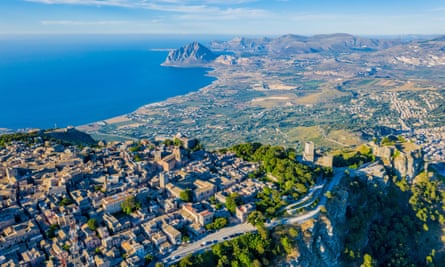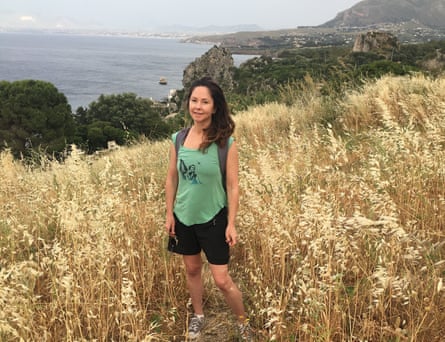
There’s something immensely satisfying about being able to see the point you’re aiming for on a long hike. Far below Erice, a hilltop town in north-west Sicily, I can make out the arc of Trapani on the coast – my target, three hours away by foot. Paths wind down the hillside, past wild flowers and giant cacti, the city looming ever larger, its buildings a palette of pastel pinks and greys that blend into the surrounding salt flats and ocean.
I’d come to explore north-western Sicily on a self-guided walking holiday, staying in small, family-run hotels and covering an average of 10km a day. Closer to north Africa than the Italian mainland, it’s a starkly beautiful and wild region, with multi-layered history thanks to myriad invaders over the centuries.
Medieval Erice, just two hours from Palermo and reached via a winding mountain road, is a town of churches, cats, cobblestones and pastry shops – a great base for a couple of nights. At Hotel Elimo, within the mighty limestone city walls, manager Antonio welcomes me. “Yesterday was all mist and clouds,” he says as I admire the sweeping views out to sea from the restaurant terrace. “Today you could almost see Tunisia!”
I wander out into the warm evening, the streets quieter now day-trippers have gone, and follow a labyrinth of narrow alleys, pocked with little squares. At Piazza della Loggia I stop for a spritz and arancini, the sound of church bells in the air. There are 60 churches in town, the gothic Chiesa Madre (the Duomo, dating from 1314) and medieval San Giovanni among those worth a visit.
Fuelled by genovesi (traditional Sicilian pastries filled with custard or ricotta), I venture out the next morning on a half-day circular route around Mount Erice. I cross the old Spanish quarter, leave town via Porta Spada and head down a wooded hillside. Wide panoramic views open out over the plains and coast and I hike under unbroken blue skies, the landscape alive with butterflies and bees. The path winds below the eccentric Torretta Pepoli and Castello di Venere, a Norman castle built on the site of an ancient temple (Erice was once a religious centre devoted to the cult of Venus). Later I potter in the Balio gardens, adjacent to the castle. Dinner at Venus feels well earned (the regional busiate pasta with Trapanese pesto is delicious).

My journey continues early the next day with the downhill hike to Trapani. I pass under the cable car (why ride when you can walk?) and continue along a zigzagging footpath. After a couple of hours I hit the outskirts of town, and a wide tree-lined avenue leads into the centre. The old town lies beyond, its ancient streets and squares squeezed into a narrow isthmus.
The full walking holiday itinerary with Inntravel includes three nights on Favignana, one of the Egadi islands, half an hour by ferry from Trapani, as well as walks on its small neighbour Levanzo. These sleepy isles offer hikes on sun-scorched hills and through pine forests, past fishing villages and along craggy coasts, with lots of opportunities for long lunches and swims in pristine waters (the area is a marine reserve). But with limited time, I stick to the mainland, heading the next day to Scopello, a Moorish village on the coast and gateway to Zingaro nature reserve, by taxi.

The quiet rural landscape grows steadily more rugged until, over the crest of a hill, Scopello’s medieval watch tower appears, silhouetted against the azure ocean. The village sits high on a plateau looking down on the rocky coastline, an 18th-century baglio (old farm) with a cobbled courtyard at its heart, surrounded by cafes and restaurants. Hotel Torre Bennistra is a delightful, traditional place and I watch the sun melt into the sea from my little balcony.
Zingaro nature reserve, the first in Sicily, was created in 1981 after thousands of people marched against plans to build a coastal road from Scopello to San Vito to the north-west. An artwork portraying the protesters at the park entrance commemorates the march, which resulted in 1,600 hectares and a 7km stretch of coastline being protected.
It’s staggering beautiful; steep sheer cliffs (some over 900 metres) plunge down to white-pebbled coves lapped by turquoise waters. The subtropical landscape, rich in prickly pear and dwarf palm, is home to diverse wildlife, with around 39 species of bird, including the rare Bonelli’s eagle (smaller and more agile than the golden eagle, which might be spotted too).
There are several hiking options. I plump for a dramatic 14km circular route following lower and medium-high paths. A long upwards stretch is rewarded by the sight of kestrels whirling overhead and the scent of wild fennel in the air. Best of all is the choice of coves to dip down into – each one more lovely than the last, the translucent waters a balm for hot, tired limbs.

I make it back to Scopello in time to check out the Tonnara, a former tuna factory in a tiny bay below the village. In operation from the 13th century until the 1980s, there’s now a small museum showcasing the history of mattanza (the massacre of hundreds of tuna, a spectacle that once was fundamental to the island’s way of life, now abandoned). Other terracotta-coloured buildings have been turned into tasteful shuttered apartments right on the water’s edge. Those not staying can visit between 10am and 7pm and take a guided tour or just sunbathe and swim off the rocks. It feels like a dreamy film set, too perfect to be real – the Torre di Scopello rising above the cove, rocky outcrops just out to sea, adding drama to the clearest of water – and an appropriate end to my wanderings through a beguiling corner of Italy.
The trip was provided by Inntravel. The seven-night Wonders of Western Sicily itinerary costs from £825pp, including three-star hotel accommodation, breakfast, transfers, luggage transportation, GPS navigation, route notes, maps and return ferry to Favignana.


